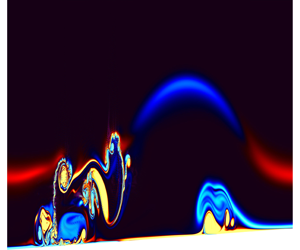Crossref Citations
This article has been cited by the following publications. This list is generated based on data provided by
Crossref.
Dauhajre, Daniel P.
Molemaker, M. Jeroen
McWilliams, James C.
and
Hypolite, Delphine
2021.
Effects of Stratification on Shoaling Internal Tidal Bores.
Journal of Physical Oceanography,
Vol. 51,
Issue. 10,
p.
3183.
Zhang, Jiuming
Sun, Tiezhi
Zou, Li
Wen, Zehua
and
Yu, Zongbing
2021.
Spectral analysis of internal solitary waves propagating over a stepped bottom topography via the Koopman operator.
AIP Advances,
Vol. 11,
Issue. 4,
Zou, Li
Wen, Zehua
Sun, Tiezhi
Ma, Xinyu
and
Wang, Xueyu
2021.
Experimental study on transformation and energy properties of depression internal solitary wave over a bottom step.
Physics of Fluids,
Vol. 33,
Issue. 3,
Grace, Andrew P.
Stastna, Marek
Lamb, Kevin G.
and
Andrea Scott, K.
2021.
Asymmetries in gravity currents attributed to the nonlinear equation of state.
Journal of Fluid Mechanics,
Vol. 915,
Issue. ,
Hartharn-Evans, Samuel G.
Carr, Magda
Stastna, Marek
and
Davies, Peter A.
2022.
Stratification effects on shoaling internal solitary waves.
Journal of Fluid Mechanics,
Vol. 933,
Issue. ,
Ghassemi, Amin
Zahedi, Saeid
and
Boegman, Leon
2022.
Bolus formation from fission of nonlinear internal waves over a mild slope.
Journal of Fluid Mechanics,
Vol. 932,
Issue. ,
Li, Jingyuan
Zhang, Qinghe
and
Chen, Tongqing
2022.
ISWFoam: a numerical model for internal solitary wave simulation in continuously stratified fluids.
Geoscientific Model Development,
Vol. 15,
Issue. 1,
p.
105.
Bian, Changwei
Ruan, Xiudan
Wang, Haonan
Jiang, Wensheng
Liu, Xiaolei
and
Jia, Yonggang
2022.
Internal solitary waves enhancing turbulent mixing in the bottom boundary layer of continental slope.
Journal of Marine Systems,
Vol. 236,
Issue. ,
p.
103805.
Zahedi, Saeid
Ghassemi, Amin
and
Boegman, Leon
2023.
Bolus degeneration on uniform slopes.
Estuarine, Coastal and Shelf Science,
Vol. 280,
Issue. ,
p.
108190.
Hartharn-Evans, Samuel G.
Stastna, Marek
and
Carr, Magda
2023.
Dense pulses formed from fissioning internal waves.
Environmental Fluid Mechanics,
Vol. 23,
Issue. 2,
p.
389.
Ellevold, Thea J.
and
Grue, John
2023.
Calculation of internal-wave-driven instability and vortex shedding along a flat bottom.
Journal of Fluid Mechanics,
Vol. 966,
Issue. ,
He, Xiao
Chen, Xu
Li, Qun
Xu, Tao
and
Meng, Jing
2023.
Numerical Simulations and an Updated Parameterization of the Breaking Internal Solitary Wave Over the Continental Shelf.
Journal of Geophysical Research: Oceans,
Vol. 128,
Issue. 11,
Guo, Yulin
Li, Qun
Chen, Xu
Peng, Jianhao
and
He, Xiao
2024.
Dynamic analysis on the interaction of two successive internal solitary waves with a ridge.
Physics of Fluids,
Vol. 36,
Issue. 6,
Guo, Yulin
Chen, Xu
Li, Qun
and
Meng, Jing
2024.
Laboratory study of the breaking and energy distribution of internal solitary waves over a ridge.
Journal of Fluid Mechanics,
Vol. 1000,
Issue. ,
Stastna, Marek
and
Legare, Sierra
2024.
Simulations of shoaling large-amplitude internal waves: perspectives and outlook.
Flow,
Vol. 4,
Issue. ,
Tian, Zhuangcai
Huang, Jinjian
Xiang, Jiaming
and
Zhang, Shaotong
2024.
Suspension and transportation of sediments in submarine canyon induced by internal solitary waves.
Physics of Fluids,
Vol. 36,
Issue. 2,
Zhi, Changhong
Xu, Shuangdong
and
Cong, Shuai
2025.
Fission dynamics and post-slope evolution of nonlinear internal waves over gentle continental shelves.
Physics of Fluids,
Vol. 37,
Issue. 2,
